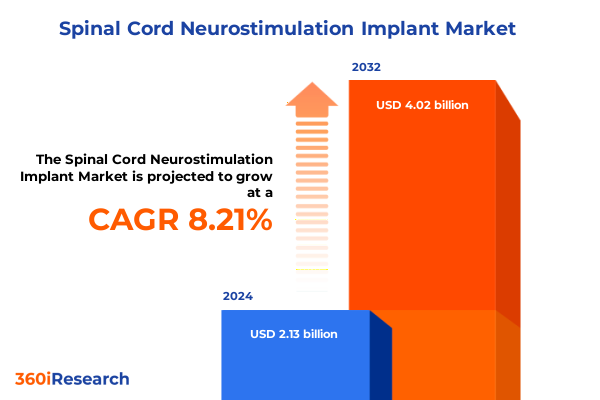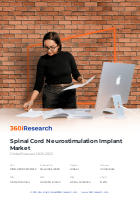The Spinal Cord Neurostimulation Implant Market size was estimated at USD 2.13 billion in 2024 and expected to reach USD 2.30 billion in 2025, at a CAGR of 8.21% to reach USD 4.02 billion by 2032.

Transformative Potential of Spinal Cord Neurostimulation Implants in Addressing Chronic Pain and Movement Disorder Challenges
Spinal cord neurostimulation implants have emerged as transformative solutions in neuromodulation, offering renewed hope for individuals grappling with chronic pain and debilitating movement disorders. These implantable systems deliver targeted electrical impulses to the spinal cord, modulating neural pathways to alleviate symptoms that have proven resistant to conventional therapies. With over two decades of technological maturation, recent innovations have sharpened the precision and safety of these devices, redefining clinical outcomes across diverse patient populations.
As the global healthcare community confronts an escalating burden of neuropathic pain and neurodegenerative conditions, the imperative for advanced pain management strategies has intensified. Health systems are increasingly recognizing the value of neurostimulation implants not only in improving quality of life but also in reducing long-term analgesic dependencies and associated healthcare expenditures. This confluence of clinical necessity and economic pressure underscores the timeliness of a strategic exploration into the current state and future trajectory of spinal cord neurostimulation implants.
How Real Time Feedback Control and Rechargeable Innovations Are Elevating Neurostimulation to Intelligent, Personalized Therapy
In recent years, the spinal cord neurostimulation landscape has undergone a tectonic shift driven by breakthroughs in both device architecture and neurophysiological understanding. Closed loop systems, which dynamically adjust stimulation parameters based on real-time neural feedback, are supplanting traditional open loop platforms by delivering more personalized and adaptive therapy. Concurrently, the proliferation of rechargeable implantable batteries has extended device longevity, mitigating the need for frequent surgical replacements and enhancing patient convenience.
Regulatory agencies have also catalyzed this evolution by streamlining pathways for novel device approvals and emphasizing post-market surveillance to ensure ongoing safety and efficacy. Parallel advancements in digital health-such as remote programming capabilities and cloud-based patient monitoring-are further blurring the boundaries between clinic and home, enabling seamless therapy optimization. Together, these developments are charting a new era in which neurostimulation implants evolve from static, one-size-fits-all tools into intelligent, patient-centric systems capable of continuous adaptation.
Navigating Tariff Induced Cost Pressures and Supply Chain Realignment in the United States Medical Device Sector
The United States government’s implementation of targeted tariffs on imported neurostimulation components in early 2025 has reverberated across supply chains and procurement strategies. As device manufacturers source critical materials and specialized electronics from abroad, these levies have translated into measurable cost inflation. Healthcare providers and payers are now contending with higher price points, triggering renewed emphasis on value-based procurement and total cost of ownership models.
In response, many industry stakeholders are exploring localized component production, forging partnerships with domestic suppliers, or reengineering product designs to minimize tariff-exposed inputs. While these measures can dampen near-term cost pressures, they also necessitate complex supply chain restructuring and potential tradeoffs in device performance or feature sets. Consequently, the tariff environment has become a strategic inflection point, compelling implant manufacturers and healthcare systems to balance innovation ambitions against fiscal constraints.
Uncovering Critical Performance Drivers Across Rechargeable, Closed Loop, Chronic Pain and Ambulatory Care Segments
Analyzing spinal cord neurostimulation implants through the lens of product, technology, application, and end user segmentation reveals distinct performance drivers and adoption dynamics. Within the product sphere, rechargeable platforms continue to outpace non rechargeable alternatives by offering extended service life and reduced surgical intervention rates, thereby attracting both clinicians and patients seeking long-term value. Technological classification further distinguishes closed loop systems, whose real time feedback mechanisms enable dose optimization, from open loop configurations, which maintain traditional fixed parameter stimulation. Application based segmentation highlights how chronic pain indications-spanning cancer related pain, limb discomfort, and lower back pain-dominate demand profiles, while movement disorder treatment, notably for multiple sclerosis and Parkinson’s disease, is emerging as a significant growth frontier. On the end user front, ambulatory surgical centers are gaining traction as cost efficient implantation venues, hospitals remain essential for high complexity cases, and specialty clinics are increasingly recognized for their multidisciplinary care models and post implant programming expertise.
This comprehensive research report categorizes the Spinal Cord Neurostimulation Implant market into clearly defined segments, providing a detailed analysis of emerging trends and precise revenue forecasts to support strategic decision-making.
- Product Type
- Technology
- Application
- End User
Regional Market Dynamics Shaping Growth Trajectories in Americas, Diverse EMEA and Emerging Asia Pacific Ecosystems
Geographically, the Americas have solidified their leadership in spinal cord neurostimulation through robust reimbursement frameworks, widespread clinical adoption, and deep installed device bases. The region’s well established healthcare infrastructure and favorable regulatory environment have fostered high patient penetration rates, particularly for chronic lower back pain indications. In Europe, the Middle East, and Africa, heterogenous healthcare funding models and varying approval timelines create a mosaic of market maturity levels; Western Europe champions early adoption in innovative centers of excellence, while emerging markets within the EMEA region display nascent uptake constrained by budgetary pressures and limited specialist access.
The Asia-Pacific territory is characterized by rapid growth driven by increasing healthcare expenditure, growing prevalence of neuropathic conditions, and accelerating investment in advanced medical technologies. Countries such as Japan and Australia lead in regulatory alignment and clinical trial activity, whereas India and Southeast Asian markets are advancing through localized manufacturing initiatives and tiered pricing models. These regional dynamics underscore the necessity for tailored market entry strategies that align device value propositions with local healthcare delivery and reimbursement landscapes.
This comprehensive research report examines key regions that drive the evolution of the Spinal Cord Neurostimulation Implant market, offering deep insights into regional trends, growth factors, and industry developments that are influencing market performance.
- Americas
- Europe, Middle East & Africa
- Asia-Pacific
Strategic Collaborations and R&D Intensification Driving Competitive Differentiation in the Neurostimulation Arena
Leading players within the spinal cord neurostimulation domain continue to invest heavily in research and development to fortify their product portfolios and sustain clinical differentiation. Established medical device firms are leveraging their scale to accelerate closed loop system rollouts, optimize rechargeable power packs, and expand remote programming platforms. Meanwhile, agile newcomers and specialized biotech ventures are challenging incumbents through targeted innovations, such as ultra miniaturized electrode arrays and novel waveform modulation techniques. Strategic collaborations-ranging from co development partnerships to licensing agreements-are becoming increasingly prevalent as companies seek to pool expertise, mitigate regulatory risks, and expedite market access.
This comprehensive research report delivers an in-depth overview of the principal market players in the Spinal Cord Neurostimulation Implant market, evaluating their market share, strategic initiatives, and competitive positioning to illuminate the factors shaping the competitive landscape.
- Medtronic plc
- Abbott Laboratories
- Boston Scientific Corporation
- Nevro Corp
- LivaNova PLC
- Nuvectra Corporation
- Flowonix Medical, Inc
- Stimwave LLC
- Saluda Medical Pty Ltd
- Mainstay Medical International plc
Building Modular Platforms and Resilient Supply Chains While Aligning Stakeholder Incentives Around Patient Outcomes
To thrive amidst escalating cost pressures, technological disruption, and shifting reimbursement landscapes, industry leaders should prioritize modular platform design that facilitates rapid feature upgrades without full system replacement. Cultivating resilient, diversified supply chains-anchored by a blend of domestic and international partners-will be critical to mitigating tariff risks and ensuring uninterrupted device availability. Moreover, enhancing digital health integration through secure remote monitoring and teleprogramming capabilities will not only create new patient engagement models but also provide real world data for continuous product improvement. Finally, establishing cross functional alliances with payers and healthcare providers can unlock novel value based contracting arrangements, aligning stakeholder incentives around patient centric outcome metrics.
Leveraging Triangulated Data From Clinical Studies, Expert Interviews, and Regulatory Filings for Rigorous Market Intelligence
This analysis synthesizes insights drawn from comprehensive secondary research, industry white papers, regulatory filings, and peer reviewed clinical studies. Augmenting these sources, structured interviews with key opinion leaders, neurosurgeons, and hospital procurement executives were conducted to capture real world perspectives on clinical adoption, reimbursement hurdles, and technology preferences. Data triangulation ensured consistency across varying information reservoirs, and thematic analysis techniques distilled core trends driving market evolution. The confluence of qualitative and quantitative methods underpins the report’s rigor, offering stakeholders a holistic understanding of the spinal cord neurostimulation implant landscape.
This section provides a structured overview of the report, outlining key chapters and topics covered for easy reference in our Spinal Cord Neurostimulation Implant market comprehensive research report.
- Preface
- Research Methodology
- Executive Summary
- Market Overview
- Market Insights
- Cumulative Impact of United States Tariffs 2025
- Cumulative Impact of Artificial Intelligence 2025
- Spinal Cord Neurostimulation Implant Market, by Product Type
- Spinal Cord Neurostimulation Implant Market, by Technology
- Spinal Cord Neurostimulation Implant Market, by Application
- Spinal Cord Neurostimulation Implant Market, by End User
- Spinal Cord Neurostimulation Implant Market, by Region
- Spinal Cord Neurostimulation Implant Market, by Group
- Spinal Cord Neurostimulation Implant Market, by Country
- Competitive Landscape
- List of Figures [Total: 28]
- List of Tables [Total: 483 ]
Integrating Technological Advancements, Trade Dynamics, and Regional Nuances to Illuminate the Future of Neuromodulation Research
The spinal cord neurostimulation implant sector stands at a pivotal juncture, propelled by the convergence of adaptive technologies, evolving clinical paradigms, and shifting economic headwinds. Rechargeable, closed loop systems are setting new benchmarks for safety and efficacy, while regional nuances in adoption continue to shape competitive strategies. The United States tariffs of 2025 underscore the interplay between trade policy and healthcare innovation, spotlighting the need for agile manufacturing and supply chain reconfiguration. As leading firms refine their offerings and stakeholders recalibrate value frameworks, the promise of advanced neuromodulation to deliver personalized, efficacious care for chronic pain and movement disorders has never been clearer.
This executive summary lays the groundwork for a deeper exploration of the critical variables influencing product development, market entry, and long term sustainability. By understanding the intricate web of technological, regulatory, and economic factors at play, decision makers can craft informed strategies to harness the full potential of spinal cord neurostimulation implants.
Unlock Strategic Insights and Secure Your Competitive Edge in Spinal Cord Neurostimulation by Engaging Directly with Our Expert
To explore how a comprehensive spinal cord neurostimulation implant report can transform your strategic planning and unlock competitive advantages, reach out to Ketan Rohom at your earliest convenience. By leveraging this in-depth analysis, you stand to gain a nuanced understanding of evolving patient needs, regulatory landscapes, and technological breakthroughs. Connect with Ketan today to secure your copy of the market research report and catalyze your organization’s leadership in the next wave of neuromodulation innovation

- How big is the Spinal Cord Neurostimulation Implant Market?
- What is the Spinal Cord Neurostimulation Implant Market growth?
- When do I get the report?
- In what format does this report get delivered to me?
- How long has 360iResearch been around?
- What if I have a question about your reports?
- Can I share this report with my team?
- Can I use your research in my presentation?




